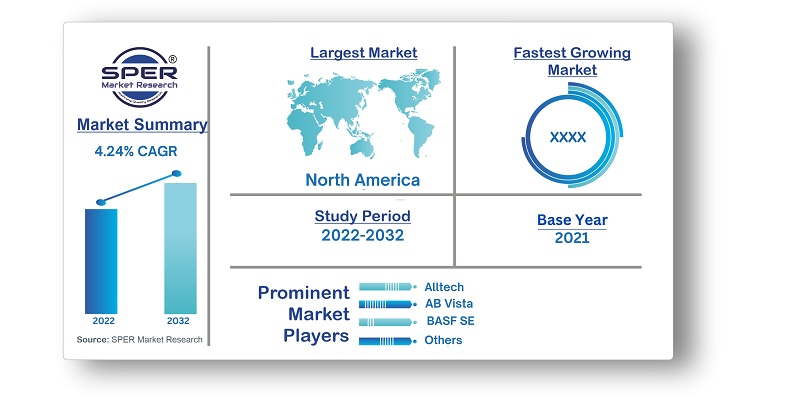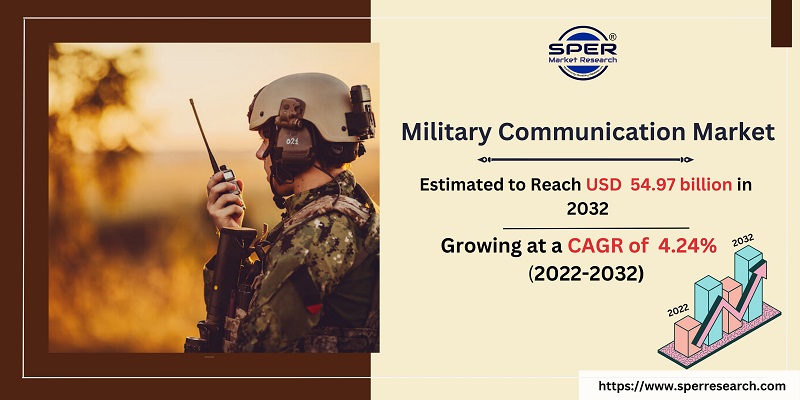
Military Communication Market Growth, Size, Technologies, Revenue, Scope and Future Outlook
Military Communication Market Size- By Application, By Component, By Communication Type, By End User, By Technology- Regional Outlook, Competitive Strategies and Segment Forecast to 2032
| Published: Mar-2023 | Report ID: AERO2312 | Pages: 1 - 240 | Formats*: |
| Category : Aerospace and Defence | |||


| Report Metric | Details |
| Market size available for years | 2019-2032 |
| Base year considered | 2021 |
| Forecast period | 2022-2032 |
| Segments covered | By Application, By Component, By Communication Type, By End User, By Technology |
| Regions covered | Asia-Pacific, Europe, Middle East and Africa, North America, Latin America |
| Companies Covered | Alltech, AB Vista, Angel Yeast Co, BASF SE, CJ Cheil Jedang Corp., Diana Group, Evonik Industries, AG, General Dynamics Corporation, Harvest Fuel Sweetpro Feeds, Kemin Industries, Lockheed Martin Corporation, Novus International, Novozymes, Olam International, Raytheon Company, Thales Group |
- Government Bodies
- Defense Personnel’s
- Telecommunication Industry
- Command & Control
- Routine Operations
- Situational Awareness
- Fleet Satellite Communications System (FLTSATCOM)
- Military Strategic and Tactical Relay (MILSTAR)
- Mobile Satellite Service (MSS)
- Small Aperture Terminal (VSAT)
- Airborne Communications
- Air-Ground Communications
- Ground-Based Communications
- Ship borne Communications
- Underwater Communications
- Air Forces
- Land Forces
- Naval Forces
- Data Link
- HF Communication
- VHF/UHF/L-BAND
- Asia-Pacific
- Europe
- Middle East & Africa
- North America
- Latin America
- Size of Global Military Communication Market (FY’2019-FY’2032)
- Overview of Global Military Communication Market
- Segmentation of Global Military Communication Market By Application (Command & Control, Routine Operations, Situational Awareness , Others)
- Segmentation of Global Military Communication Market By Component {Small Aperture Terminal (VSAT), Fleet Satellite Communications System (FLTSATCOM), Mobile Satellite Service (MSS), Military Strategic and Tactical Relay (MILSTAR) }
- Segmentation of Global Military Communication Market By Communication Type (Airborne Communications, Air-Ground Communications, Ground-Based Communications, Ship borne Communications , Underwater Communications)
- Segmentation of Global Military Communication Market By End User (Air Forces, Land Forces, Naval Forces)
- Segmentation of Global Military Communication Market By Technology (Data Link, HF Communication, SATCOM, VHF/UHF/L-BAND)
- Growth Analysis of Global Military Communication Market
- Problems and Challenges in Global Military Communication Market
- Competitive Landscape in the Global Military Communication Market
- Impact of COVID-19 and Demonetization on Global Military Communication Market
- Details on Recent Investment in Global Military Communication Market
- Competitive Analysis of Global Military Communication Market
- Major Players in the Global Military Communication Market
- Global Military Communication Market Future Outlook and Projections (FY’2019-FY’2032)
- Recommendations from Analyst
1.1. Scope of the report1.2. Market segment analysis
2.1 Research data source2.1.1 Secondary data2.1.2 Primary data2.1.3 SPER’s internal database2.1.4 Premium insight from KOL’s2.2 Market size estimation2.2.1 Top-down and Bottom-up approach2.3 Data triangulation
4.1. Driver, Restraint, Opportunity and Challenges analysis4.1.1 Drivers4.1.2 Restraints4.1.3 Opportunities4.1.4 Challenges4.2. COVID-19 Impacts of the Global Military Communication Market
5.1. SWOT analysis5.1.1 Strengths5.1.2 Weaknesses5.1.3 Opportunities5.1.4 Threats5.2. PESTEL analysis5.2.1 Political landscape5.2.2 Economic landscape5.2.3 Social landscape5.2.4 Technological landscape5.2.5 Environmental landscape5.2.6 Legal landscape5.3. PORTER’S five forces analysis5.3.1 Bargaining power of suppliers5.3.2 Bargaining power of Buyers5.3.3 Threat of Substitute5.3.4 Threat of new entrant5.3.5 Competitive rivalry5.4. Heat map analysis
6.1 Global Military Communication Manufacturing Base Distribution, Sales Area, Product Type6.2 Mergers & Acquisitions, Partnerships, Product Launch, and Collaboration in Global Military Communication Market
7.1 Command & Control7.2 Routine Operations7.3 Situational Awareness7.4 Others
8.1 Fleet Satellite Communications System (FLTSATCOM)8.2 Military Strategic and Tactical Relay (MILSTAR)8.3 Mobile Satellite Service (MSS)8.4 Small Aperture Terminal (VSAT)
9.1 Airborne Communications9.2 Air-Ground Communications9.3 Ground-Based Communications9.4 Ship borne Communications9.5 Underwater Communications
10.1 Air Forces10.2 Land Forces10.3 Naval Forces
11.1 Data Link11.2 HF Communication11.3 SATCOM11.4 VHF/UHF/L-BAND
12.1 Global Military Communication Market Size and Market Share by Region (2019-2025)12.2 Global Military Communication Market Size and Market Share by Region (2026-2032)12.3 Asia-Pacific12.3.1 Australia12.3.2 China12.3.3 India12.3.4 Japan12.3.5 South Korea12.3.6 Rest of Asia-Pacific12.4 Europe12.4.1 France12.4.2 Germany12.4.3 Italy12.4.4 Spain12.4.5 United Kingdom12.4.6 Rest of Europe12.5 Middle East and Africa12.5.1 Kingdom of Saudi Arabia12.5.2 United Arab Emirates12.5.3 Rest of Middle East & Africa12.6 North America12.6.1 Canada12.6.2 Mexico12.6.3 United States12.7 Latin America12.7.1 Argentina12.7.2 Brazil12.7.3 Rest of Latin America
13.1 Alltech13.1.1 Company details13.1.2 Financial outlook13.1.3 Product summary13.1.4 Recent developments13.2 AB Vista.13.2.1 Company details13.2.2 Financial outlook13.2.3 Product summary13.2.4 Recent developments13.3 Angel Yeast Co.13.3.1 Company details13.3.2 Financial outlook13.3.3 Product summary13.3.4 Recent developments13.4 BASF SE13.4.1 Company details13.4.2 Financial outlook13.4.3 Product summary13.4.4 Recent developments13.5 CJ CheilJedang Corp.13.5.1 Company details13.5.2 Financial outlook13.5.3 Product summary13.5.4 Recent developments13.6 Diana Group13.6.1 Company details13.6.2 Financial outlook13.6.3 Product summary13.6.4 Recent developments13.7 Evonik Industries AG13.7.1 Company details13.7.2 Financial outlook13.7.3 Product summary13.7.4 Recent developments13.8 General Dynamics Corporation13.8.1 Company details13.8.2 Financial outlook13.8.3 Product summary13.8.4 Recent developments13.9 Harvest Fuel Sweetpro Feeds13.9.1 Company details13.9.2 Financial outlook13.9.3 Product summary13.9.4 Recent developments13.10 Kemin Industries13.10.1 Company details13.10.2 Financial outlook13.10.3 Product summary13.10.4 Recent developments13.11 Lockheed Martin Corporation13.11.1 Company details13.11.2 Financial outlook13.11.3 Product summary13.11.4 Recent developments13.12 Novus International13.12.1 Company details13.12.2 Financial outlook13.12.3 Product summary13.12.4 Recent developments13.13 Novozymes13.13.1 Company details13.13.2 Financial outlook13.13.3 Product summary13.13.4 Recent developments13.14 Olam International13.14.1 Company details13.14.2 Financial outlook13.14.3 Product summary13.14.4 Recent developments13.15 Raytheon Company.13.15.1 Company details13.15.2 Financial outlook13.15.3 Product summary13.15.4 Recent developments13.16 Thales Group.13.16.1 Company details13.16.2 Financial outlook13.16.3 Product summary13.16.4 Recent developments
SPER Market Research’s methodology uses great emphasis on primary research to ensure that the market intelligence insights are up to date, reliable and accurate. Primary interviews are done with players involved in each phase of a supply chain to analyze the market forecasting. The secondary research method is used to help you fully understand how the future markets and the spending patterns look likes.
The report is based on in-depth qualitative and quantitative analysis of the Product Market. The quantitative analysis involves the application of various projection and sampling techniques. The qualitative analysis involves primary interviews, surveys, and vendor briefings. The data gathered as a result of these processes are validated through experts opinion. Our research methodology entails an ideal mixture of primary and secondary initiatives.



Frequently Asked Questions About This Report
PLACE AN ORDER
Year End Discount
Sample Report
Pre-Purchase Inquiry
NEED CUSTOMIZATION?
Request CustomizationCALL OR EMAIL US
100% Secure Payment






Related Reports
Our Global Clients
Our data-driven insights have influenced the strategy of 200+ reputed companies across the globe.




















